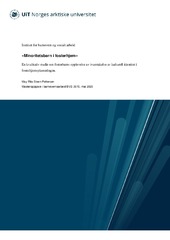| dc.contributor.advisor | Anne Riise | |
| dc.contributor.author | Pettersen, May Rita Steen | |
| dc.date.accessioned | 2025-07-06T08:31:37Z | |
| dc.date.available | 2025-07-06T08:31:37Z | |
| dc.date.issued | 2025 | |
| dc.description.abstract | Sammendrag
Stadig flere minoritetsbarn plasseres i fosterhjem. Spørsmålet som er aktuelle å stille seg i den forbindelse er bør minoritetsbarn plasseres i majoritetsfosterhjem, eller bør barnet plasseres i ett hjem som har samme kulturelle bakgrunn.
Følgende problemstilling ligger til grunn for studiet:
Hvordan opplever minoritetsbarn at deres identitet og kultur ivaretas ved plassering i fosterhjem?
Formålet med denne studiet har vært å utforske betydningen av ivaretakelse av kultur og identitet når minoritetsbarn plasseres av barneverntjenesten i majoritetsfosterhjem, samtidig har og formålet vært å sette et større fokus på ivaretakelsen av minoritetsbarn i barnevernet.
Dataene ble samlet inn gjennom semistrukturerte intervjuer med tre informanter. Intervjuene ble analysert ved bruk av tematisk analyse. Analysen avdekket tre hovedkategorier knyttet til ivaretakelsen av kulturen til minoritetsbarna. 1) Manglende fokus på opprinnelseskulturen) 2) Identitetsendring 3) Medvirkning.
Informantene beskrev en manglende oppfølgning fra barneverntjenestens knyttet til ivaretakelse av opprinnelseskulturen deres. Det kom frem at det var delte opplevelser knyttet til medvirkning. Videre påpekte samtlige informanter at det ikke var et alternativ for dem å bli plassert i et fosterhjem med samme opprinnelse ettersom de knyttet opplevelsene fra foreldrehjemmene til kulturen.
Studien viser et kompleks og sammensatt område hvor det fremkommer manglende oppfølgning fra barnevern og fosterhjem. | |
| dc.description.abstract | Summary
An increasing number of minority children are placed in foster homes. The question that is relevant to ask in this connection is should minority children be placed in a majority foster home, or should the child be placed in a home that has the same cultural background.
The following research question forms the basis of the study:
How do minority children feel that their identity and culture are safeguarded when placed in foster care?
The purpose of this study has been to explore the importance of safeguarding culture and identity when minority children are placed by the child welfare service in majority foster homes, at the same time as the purpose has been to put a greater focus on the care of minority children in the child welfare service.
The purpose of this study has been to explore the importance of safeguarding culture and identity when minority children are placed by the child welfare service in majority foster homes, at the same time as the purpose has been to put a greater focus on the care of minority children in the child welfare service.
The data were collected through semi-structured interviews with three informants. The interviews were analysed using thematic analysis. The analysis revealed three main categories related to safeguarding the culture of minority children. 1) Lack of focus on the culture of origin) 2) Identity change 3) Participation
The informants described a lack of follow-up from the child welfare services related to safeguarding their culture of origin. It emerged that there were shared experiences related to participation. Furthermore, all the informants pointed out that it was not an option for them to be placed in a foster home with the same origin, as they linked their experiences from their parents' homes to the culture.
The study shows a complex and complex area. There is a lack of follow-up from child welfare and foster homes, which affects minority children after the placement. | |
| dc.identifier.uri | https://hdl.handle.net/10037/37435 | |
| dc.identifier | no.uit:wiseflow:7270148:62368699 | |
| dc.language.iso | nob | |
| dc.publisher | UiT The Arctic University of Norway | |
| dc.rights.holder | Copyright 2025 The Author(s) | |
| dc.rights.uri | https://creativecommons.org/licenses/by/4.0 | en_US |
| dc.rights | Attribution 4.0 International (CC BY 4.0) | en_US |
| dc.title | «Minoritetsbarn i fosterhjem» | |
| dc.type | Master thesis | |


 English
English norsk
norsk
